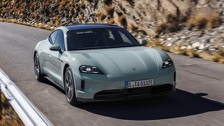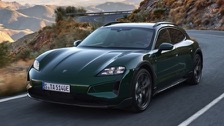Price from * £100,000
| Availability |
Expected |
| Available to order from |
June 2024 |
| Available to order until |
- |
| Annual VED |
£0 |
| Congestion Charge * |
£0 |
| Insurance Group * |
50 |
Price shown is an estimated On The Road Price: it includes VAT, first year VED, vehicle first registration fee, number plates and delivery. Contract hire estimate by
e-car lease t/a CarLease (UK) Ltd who are a credit broker not a lender. Offer based on a business contract hire usership agreement, 6+35 profile, 10,000 miles per annum, excluding optional maintenance package and subject to VAT. Prices subject to terms and conditions.
Real Range between 255 - 490 mi
| City - Cold Weather |
325 mi |
| Highway - Cold Weather |
255 mi |
| Combined - Cold Weather |
290 mi |
| City - Mild Weather |
490 mi |
| Highway - Mild Weather |
330 mi |
| Combined - Mild Weather |
400 mi |
Indication of real-world range in several situations. Cold weather: 'worst-case' based on -10°C and use of heating. Mild weather: 'best-case' based on 23°C and no use of A/C. For 'Highway' figures a constant speed of 70 mph is assumed. The actual range will depend on speed, style of driving, weather and route conditions.
* Acceleration is estimated as the manufacturer specification of 2.1 sec has a 1 foot rollout subtracted. This does not comply with industry standards and makes comparison between vehicles impossible. A correction has been applied to include the rollout.
Battery
| Nominal Capacity * |
100.0 kWh |
| Battery Type |
Lithium-ion |
| Number of Cells |
7920 |
| Architecture |
400 V |
| Warranty Period |
8 years |
| Warranty Mileage |
150,000 mi |
| Useable Capacity* |
95.0 kWh |
| Cathode Material |
NCA |
| Pack Configuration |
110s72p |
| Nominal Voltage |
407 V |
| Form Factor |
No Data |
| Name / Reference |
Panasonic 18650 |
Charging
Home / Destination
| Charge Port |
Type 2 |
| Port Location |
Left Side - Rear |
| Charge Power † |
11 kW AC |
| Charge Time (0->345 mi) † |
10h15m |
| Charge Speed † |
34 mph |
Rapid Charging
| Fastcharge Port |
CCS |
| FC Port Location |
Left Side - Rear |
| Fastcharge Power (max) * |
250 kW DC |
| Fastcharge Power (10-80%) * |
140 kW DC |
| Fastcharge Time (34->276 mi) * |
30 min |
| Fastcharge Speed * |
480 mph |
| Autocharge Supported |
Yes |
Plug & Charge
| Plug & Charge Supported |
No |
† This can only be achieved using a 3-phase grid connection. The majority of homes and charge points do not have this connection. In practice charge power will often be 7.4 kW, allowing for a charge time of 15h15m and a charge speed of 23 mph.
Bidirectional Charging (V2X / BPT)
Vehicle-to-Load (V2L)
| V2L Supported |
No |
| Max. Output Power |
- |
| Exterior Outlet(s) |
- |
| Interior Outlet(s) |
- |
Vehicle-to-Home (V2H)
| V2H via AC Supported |
No |
| Max. Output Power |
- |
| V2H via DC Supported |
No |
| Max. Output Power |
- |
Vehicle-to-Grid (V2G)
| V2G via AC Supported |
No |
| Max. Output Power |
- |
| V2G via DC Supported |
No |
| Max. Output Power |
- |
Energy Consumption
EVDB Real Range
| Range |
345 mi |
| Vehicle Consumption |
275 Wh/mi |
| CO2 Emissions |
0 g/km |
| Vehicle Fuel Equivalent |
147 mpg |
WLTP Ratings
| Range |
373 mi |
| Rated Consumption |
301 Wh/mi |
| Vehicle Consumption |
255 Wh/mi |
| CO2 Emissions |
0 g/km |
| Rated Fuel Equivalent |
134 mpg |
| Vehicle Fuel Equivalent |
159 mpg |
Rated = official figures as published by manufacturer. Rated consumption and fuel equivalency figures include charging losses.
Vehicle = calculated battery energy consumption used by the vehicle for propulsion and on-board systems.
NOTE: The fuel equivalency figures are shown in IMPERIAL MPG. Figures in US MPG will differ significantly.
Real Energy Consumption between 194 - 373 Wh/mi
| City - Cold Weather |
292 Wh/mi |
| Highway - Cold Weather |
373 Wh/mi |
| Combined - Cold Weather |
328 Wh/mi |
| City - Mild Weather |
194 Wh/mi |
| Highway - Mild Weather |
288 Wh/mi |
| Combined - Mild Weather |
238 Wh/mi |
Indication of real-world energy use in several situations. Cold weather: 'worst-case' based on -10°C and use of heating. Mild weather: 'best-case' based on 23°C and no use of A/C. For 'Highway' figures a constant speed of 70 mph is assumed. The energy use will depend on speed, style of driving, climate and route conditions.
Safety (Euro NCAP)
| Safety Rating |
|
| Adult Occupant |
94% |
| Child Occupant |
91% |
| Rating Year |
2022 |
| Vulnerable Road Users |
85% |
| Safety Assist |
98% |
For more details on the safety rating of this vehicle, visit
euroncap.com
Dimensions and Weight
| Length |
5021 mm |
| Width |
1987 mm |
| Width with mirrors |
2189 mm |
| Height |
1431 mm |
| Wheelbase |
2960 mm |
| Weight Unladen (EU) |
2265 kg |
| Gross Vehicle Weight (GVWR) |
2629 kg |
| Max. Payload |
439 kg |
| Cargo Volume |
709 L |
| Cargo Volume Max |
1828 L |
| Cargo Volume Frunk |
89 L |
| Roof Load |
75 kg |
| Tow Hitch Possible |
Yes |
| Towing Weight Unbraked |
750 kg |
| Towing Weight Braked |
1600 kg |
| Vertical Load Max |
100 kg |
Miscellaneous
| Seats |
5 people |
| Isofix |
Yes, 2 seats |
| Turning Circle |
12.3 m |
| Platform |
TESLA S/X |
| EV Dedicated Platform |
Yes |
| Car Body |
Liftback Saloon |
| Segment |
Luxury |
| Roof Rails |
No |
| Heat pump (HP) |
Yes |
| HP Standard Equipment |
Yes |
Company Car Tax Indication
Financial Year 2024-25
| BIK Tax Rate |
2% |
| P11D Value from * |
£99,945 |
| Benefit in Kind (BIK) * |
£1,999 |
| BIK @ 20% * |
£33 pcm |
| BIK @ 40% * |
£67 pcm |
| BIK @ 45% * |
£75 pcm |
Financial Year 2025-26
| BIK Tax Rate |
3% |
| P11D Value from * |
£99,945 |
| Benefit in Kind (BIK) * |
£2,998 |
| BIK @ 20% * |
£50 pcm |
| BIK @ 40% * |
£100 pcm |
| BIK @ 45% * |
£112 pcm |
Financial Year 2026-27
| BIK Tax Rate |
4% |
| P11D Value from * |
£99,945 |
| Benefit in Kind (BIK) * |
£3,998 |
| BIK @ 20% * |
£67 pcm |
| BIK @ 40% * |
£133 pcm |
| BIK @ 45% * |
£150 pcm |
* = estimated value. Average energy consumption and range based on moderate drive style and climate. Real-life values may differ significantly. Pricing information might not be actual for some regions. No rights can be derived from the information on this site.
 Porsche Taycan 4S £4,100 less expensive 50 mi less range 61% slower acceleration Similar energy consumption 35% faster rapid-charging
Porsche Taycan 4S £4,100 less expensive 50 mi less range 61% slower acceleration Similar energy consumption 35% faster rapid-charging Porsche Taycan 4S Cross Turismo £400 more expensive 35 mi less range 65% slower acceleration 12% less energy efficient 42% faster rapid-charging
Porsche Taycan 4S Cross Turismo £400 more expensive 35 mi less range 65% slower acceleration 12% less energy efficient 42% faster rapid-charging Lotus Emeya £3,745 less expensive 20 mi less range 83% slower acceleration 12% less energy efficient 58% faster rapid-charging
Lotus Emeya £3,745 less expensive 20 mi less range 83% slower acceleration 12% less energy efficient 58% faster rapid-charging

